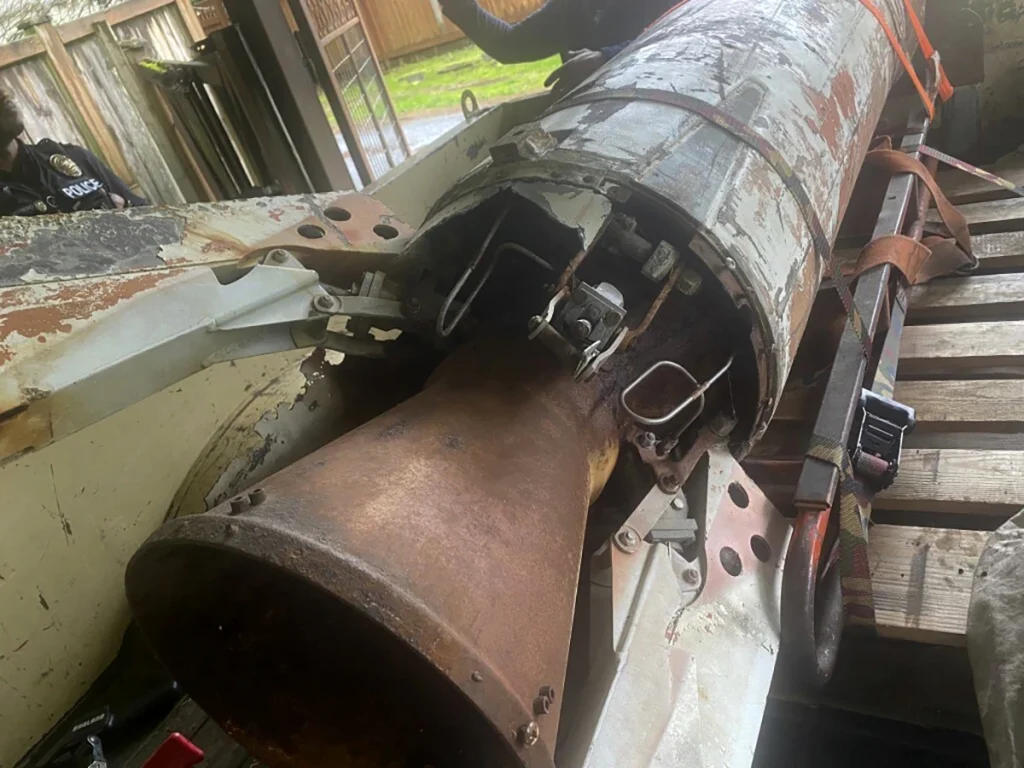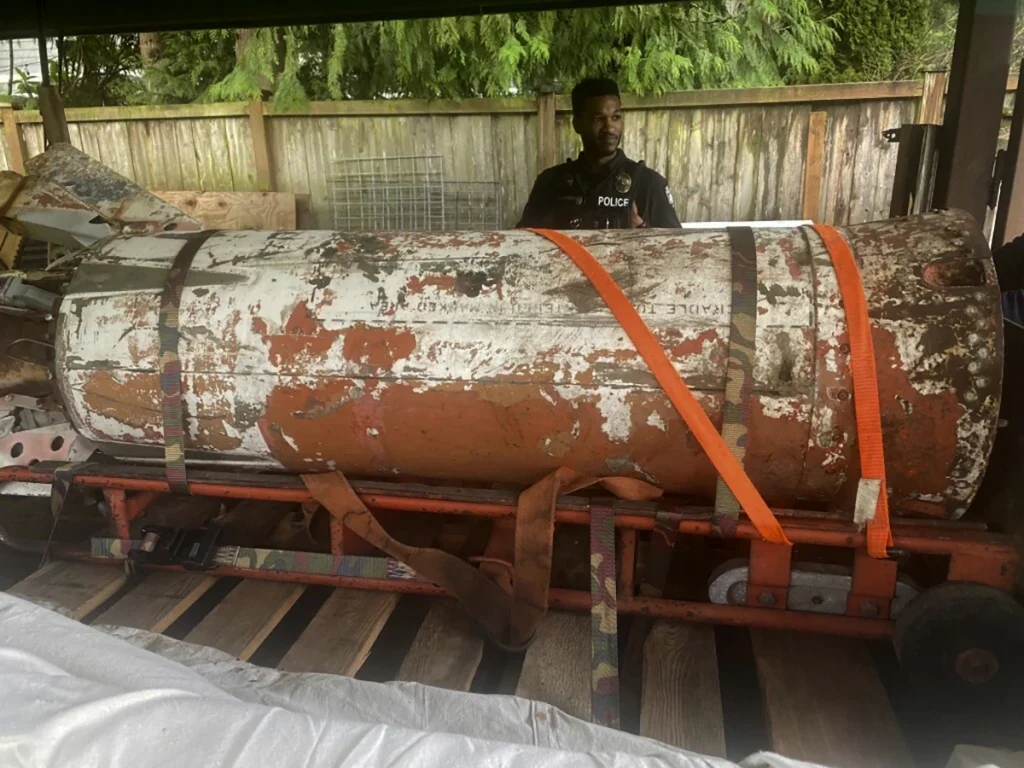The recent discovery of an inert rocket, designed to carry a nuclear warhead, in the garage of a deceased resident in Washington state has raised concerns and questions about how such a potentially dangerous item came to be in the possession of a private individual.
The incident, which took place in Bellevue, a city located across Lake Washington from Seattle, has prompted an investigation by local authorities and has sparked a discussion about the proper handling and disposal of military-grade weapons.
The discovery was made when Bellevue police responded to a report of a military-grade rocket in the garage of a home in the city.
The rocket was identified as a Douglas AIR-2 Genie, previously designated as MB-1, an unguided air-to-air rocket designed to carry a 1.5 kt W25 nuclear warhead.
However, it was determined that there was no warhead attached to the rocket and no rocket fuel present, indicating that the item was essentially an artifact with no explosive hazard.
The origins of the rocket are still unclear, but according to reports, the rocket was purchased at an estate sale by a neighbor of the deceased resident.
The neighbor then offered to donate the item to an Air Force museum in Dayton, Ohio, which prompted the museum to contact the authorities.
The fact that such a potentially dangerous item was being sold at an estate sale raises questions about the regulation and oversight of the sale of military-grade weapons and artifacts.
The discovery of the rocket has also raised concerns about the potential presence of other military-grade weapons in the possession of private individuals.
It is important for authorities to conduct a thorough investigation to ensure that there are no other hazardous items in the vicinity and to determine how the rocket came to be in the possession of the deceased resident.
In addition to the immediate concerns about the presence of the rocket, this incident also highlights the broader issue of the proper handling and disposal of military-grade weapons and artifacts.
It is crucial for authorities to have strict regulations and protocols in place for the handling and disposal of such items to prevent them from falling into the wrong hands and posing a threat to public safety.
Overall, the discovery of the inert rocket in the garage of a deceased resident in Washington state has raised important questions about the regulation and oversight of military-grade weapons and artifacts, as well as the proper handling and disposal of such items.
It is essential for authorities to conduct a thorough investigation and to take necessary steps to ensure the safety and security of the public.
In a peculiar turn of events, a seemingly inert and forgotten relic from a bygone era has resurfaced, capturing the attention of both law enforcement and history enthusiasts.
The unguided air-to-air rocket, once a pivotal component of the U.S. and Canadian military arsenal during the Cold War, has found itself at the center of an unexpected narrative.
As the saga unfolds, it brings to light not only the historical significance of the weapon but also the intricate interplay between military history, technological advancement, and the unanticipated challenges faced by law enforcement in the modern age.
The intriguing account began with a statement from the police, revealing that due to the item’s inert nature and the absence of a military request for its return, the rocket was left in the custody of a neighbor for restoration and future display in a museum.
This decision, while raising eyebrows, provided a glimpse into the unique circumstances surrounding the handling of historical artifacts with potential military implications.
According to the Air Force Armament Museum Foundation, the unguided air-to-air rocket in question played a pivotal role during a period of heightened tension in the Cold War era.
It was a time when interception of Soviet strategic bombers posed a significant military concern for the United States and its allies.
The historical context surrounding the utilization of this weapon underscores its role as a symbol of a tumultuous period in global history, where the specter of nuclear conflict loomed large.
The revelation that a Genie rocket was launched and detonated over Yucca Flats, Nevada in July 1957 added a remarkable layer of historical significance to the narrative.
This event marked the first and only test detonation of a U.S. nuclear-tipped air-to-air rocket, signifying a pivotal moment in the annals of military history.
The implications of such a test, both in terms of military strategy and the broader geopolitical landscape, underscore the gravity of this artifact and its enduring relevance in understanding the complexities of the Cold War era.
As the news of this unusual discovery spread, the response from law enforcement, notably conveyed through social media, added a touch of modernity to an otherwise historical tale.
The use of a rocket emoji in the police’s Twitter statement, coupled with the acknowledgment that such an event is unlikely to recur in the foreseeable future, served as a reminder of the unexpected and often surreal nature of contemporary law enforcement challenges.
The juxtaposition of historical artifacts with the fast-paced, digital era in which they are rediscovered reflects the dynamic nature of preserving and interpreting historical relics in the modern world.
The confluence of historical significance, technological advancement, and the unforeseen circumstances surrounding the handling of the air-to-air rocket presents a multifaceted narrative that captivates the imagination and prompts reflection on the intricate relationship between the past and the present.
It serves as a compelling reminder of the enduring relevance of historical artifacts, shedding light on the complexities of historical interpretation and the challenges of navigating the intersection of history, technology, and law enforcement in the contemporary landscape.
In conclusion, the rediscovery of the unguided air-to-air rocket from the Cold War era stands as a testament to the enduring impact of historical artifacts and their ability to captivate the public imagination.

Its unexpected journey from a forgotten relic to a subject of contemporary interest highlights the intricate interplay between history, technology, and law enforcement in the modern age.
As this captivating saga continues to unfold, it prompts us to delve deeper into the multifaceted layers of our shared history, offering a poignant reminder of the enduring relevance of historical artifacts in shaping our understanding of the past and its resonance in the present day.
